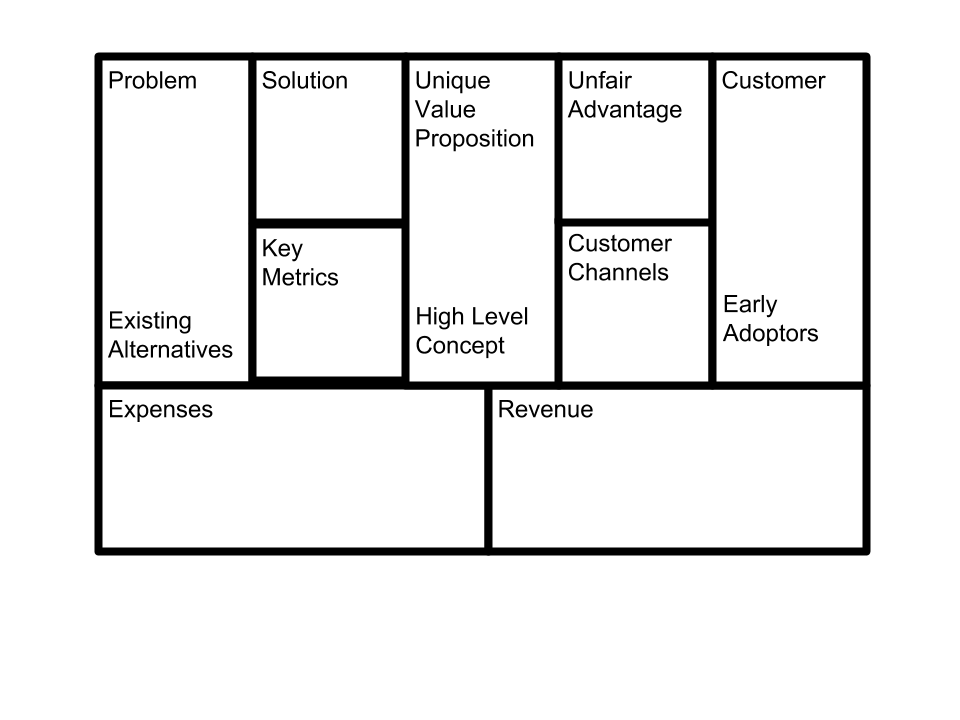As you are getting ready to pitch your startup, there are some good things to remember. First, you are going to need several pitch formats. A 30 second pitch (elevator pitch) , a 1 minute pitch, a 3 minute pitch, a 5 minute pitch, a 10 minute pitch.
These are not the same pitch slower. They are different pitches aimed at getting a specific thing to happen. That is, they are pitches in different contexts. And they all have the same overall task as a goal: To get to the next meeting.
Additionally, they all have the same foundation at the core. When you work on your Lean Canvas, you are working to illuminate that core business model. Let’s take a look at how that might work.
For the 30 second pitch, you are trying to provide enough of an overview that you get people’s attention. If we look at the Geoffrey Moore framework out of Tor Grønsund’s post:
Then we would see the following:
For ____________ (target customer)
who ____________ (statement of the need or opportunity)
our (product/service name) is ____________ (product category)
that (statement of benefit) ____________ .
Some of this looks remarkably like the Lean Canvas:
So let’s translate the Value Proposition into the same words as the Lean Canvas:
For ____________ (CUSTOMER)
who ____________ (has PROBLEM)
our (PRODUCT NAME) is ____________ (PRODUCT CATEGORY)
that ____________(UNIQUE VALUE PROPOSITION).
We might like to expand on that a little bit more:
For ____________ (CUSTOMER)
who ____________ (has PROBLEM)
our (PRODUCT NAME) is ____________ (PRODUCT CATEGORY).
Unlike existing alternatives, _______ (EXISTING ALTERNATIVE #1), _______ (EXISTING ALTERNATIVE #2), and _______ (EXISTING ALTERNATIVE #3), we provide __________ (FEATURE #1) that _____________(UNIQUE VALUE PROPOSITION).
We see that _________(CUSTOMER ) are spending __________(REVENUE - Market Size) to solve __________(PROBLEM).
This provides a little more detail on the company and how it fits into the market place.
However, there are two things that are missing: A request at the end and an attention getting mechanism at the front.
Where we have clarity in the business model, the task of pulling together an appropriate and effective pitch becomes much easier. Because you will be connecting with Investors multiple times as you engage in the process of seeking investment, it is always good to have a way to mix up the story a bit as well. Saying the same pitch over and over again, without updating and evolving it ends up being a signal to investors that you are not learning along the way. So please expect to be reworking and revising the various pieces of your pitch along the way.
Hopefully, this will help you create a specific framework that gets you started on an effective pathway to doing a good pitch. Practice this pitch process every day, with different people, and learn how it evolves and how to make it more effective. The key is to be remarkable. That is, to have other people talking about you after you have left. Typical early stage pitch sessions have a dozen or more companies presenting at the same time. Just given Human short term memory structures, only 3 or 4 of the companies presenting will be remembered. What will you do to be remarkable enough to not only be remembered, but to have the investors telling your story for you?
Everyone on your team should understand your core business model and be able to give a pitch at a moments notice. In a startup, everyone is a sales person.
No comments:
Post a Comment